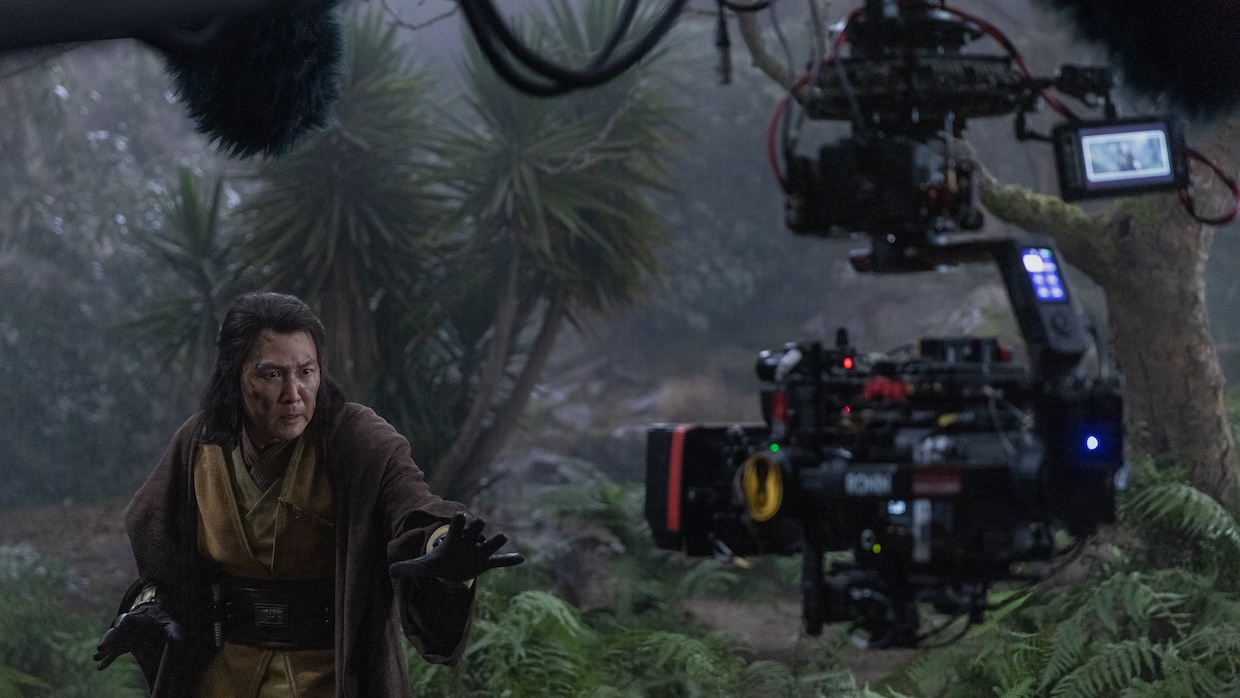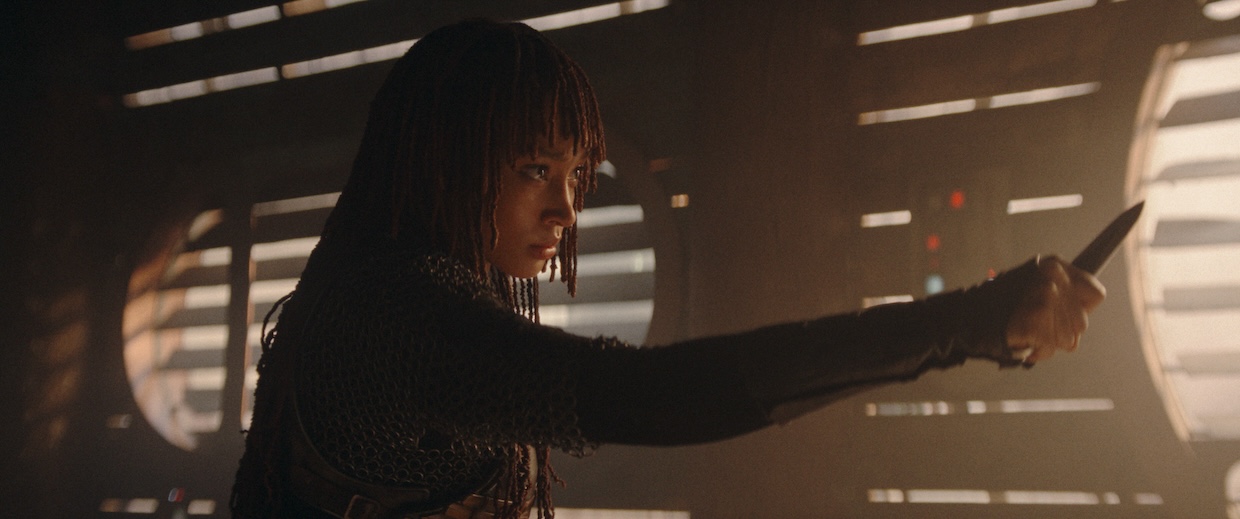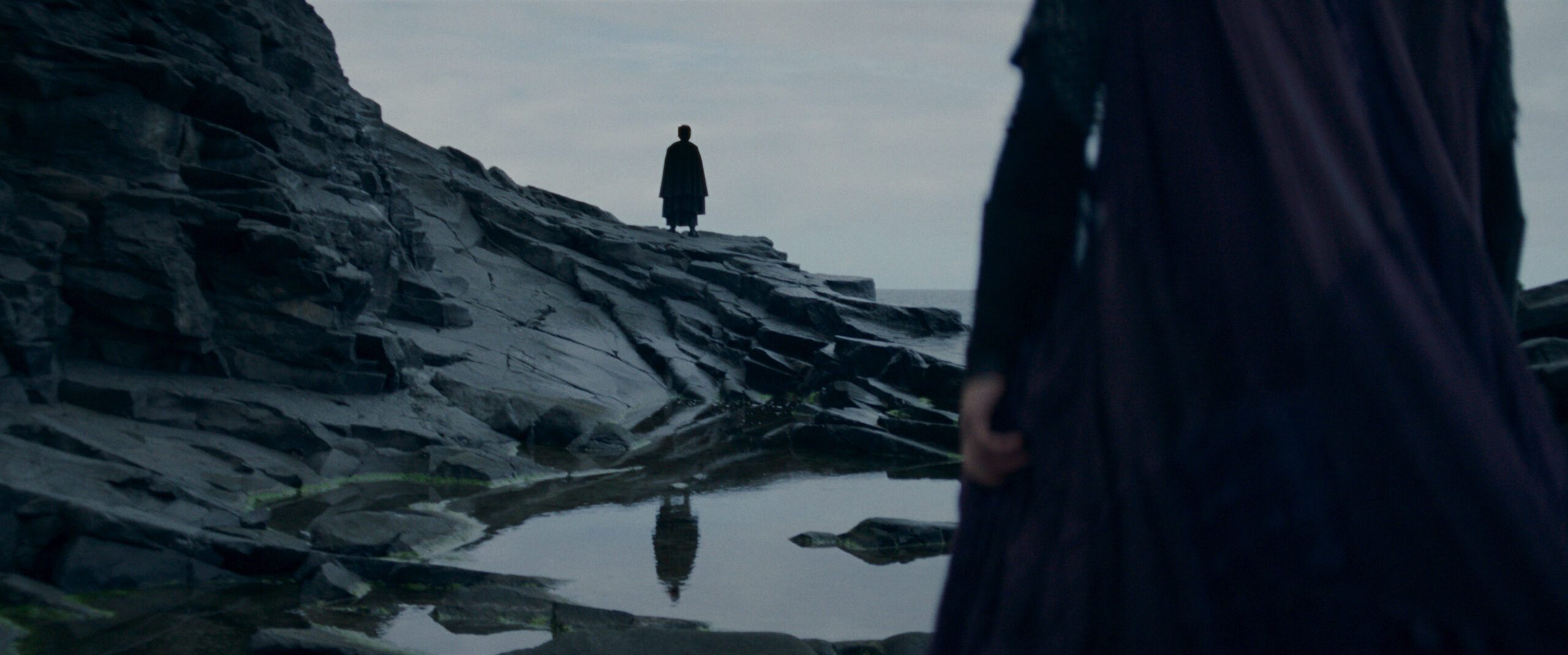 Back to selection
Back to selection
Shutter Angles
Conversations with DPs, directors and below-the-line crew by Matt Mulcahey
“Playing in the Best Sandbox Ever”: DP Chris Teague on The Acolyte
 Lee Jung-jae in The Acolyte
Lee Jung-jae in The Acolyte Set a century before The Phantom Menace, The Acolyte follows a Jedi master (Squid Games star Lee Jung-jae) and his former apprentice (Amandla Stenberg) as they hunt for a killer who’s dispatching Jedi.
The new series holds a distinction that no other live action Star Wars saga can claim—not the half dozen Disney Plus shows or the eleven feature films, not the Star Wars Holiday Special, not even that Ewok movie with Wilfred Brimley. The Acolyte is the first live action story set in the heretofore unseen High Republic era that served as the zenith of Jedi influence and power.
With the full series now streaming, cinematographer Chris Teague spoke to Filmmaker about creating the look of a new Star Wars epoch and reuniting with Russian Doll collaborator Leslye Headland.
Filmmaker: You get to do something interesting within the Star Wars universe in that you’re capturing a period that’s never been seen in live action before. What was intrinsic to Star Wars that you felt like you had to include—whether it was shooting anamorphic or having those wipe transitions—and where did you feel like you could branch out into new territory?
Teague: The original three films were the ones I saw when I was young, and I realized as I was doing research and developing the look for the show how much the aesthetics of the originals still resonated with me—the texture, the grit, this interesting juxtaposition of a world that feels very lived in and dirtied up but also has these wonderful pops of bright colors. That was something I really wanted to bring to the show. Early on, we felt like the look we wanted required something that was more practical, more handmade. We didn’t do Volume work. We had very few sets that had large components of blue screen. We obviously worked with quite a bit of blue screen, but mostly for background set extensions and things like that. We wanted to try to build as much of our sets on a stage as we could to help create a look for the show that feels to me very much like the original movies, but with this amazing added component of martial arts fight sequences. We were influenced by 1970s era martial arts films like Come Drink with Me or Lady Snowblood and the films that were influenced by that era like Kill Bill or Crouching Tiger, Hidden Dragon. The photography of those films tends to have a very dynamic style, but a very intentional style where the camera only moves on one axis at a time. It’s pushing in or pulling out, tracking left or right. It’s really there to capture this incredible fight choreography. That felt like a little bit of a throwback style very much in line with what we were trying to do with the overall look of the show.
Filmmaker: Was anamorphic a no-brainer?
Teague: Pretty much. It just feels like the way to shoot an epic Star Wars show. We did something a little different in that we shot on the Arri ALFAs, which are a modern set even though they don’t necessarily look like a modern set. They don’t feel overly sharp or pristine, but they have low distortion and are incredibly consistent across the entire range [of focal lengths]. Sometimes anamorphics can have really unique characteristics even from focal length to focal length, where things can drop out of focus in a way that surprises you, but I was very happy with the consistency and reliability of the lenses.
Filmmaker: I believe the ALFAs are rehoused, expanded Master Anamorphics that have been detuned. Did you do new tunings just for the show or were they already in a place where you liked where they were living?
Teague: We definitely considered playing with the tunings, and we did test some of the different tunings that were available to us. Ultimately, we decided to go with what they already had because it felt like the tunings as they were really threaded the perfect needle of not being too sharp, but also not having such an extreme focus fall-off that you start to worry about losing sharpness on people’s faces if they’re towards the edge of the frame. We have an ensemble cast, and one of the things we were striving for are these great group shots and we wanted to make sure we were capturing everyone.
Filmmaker: You shot Sony Venice, which you also used on Only Murders in the Building.
Teague: We did the Venice 2, which felt very much in line with the original camera sensor. It’s a smaller body, which is really nice. We were also able to get our hands on one of the first prototypes of [the new version of] the Rialto, which was handy, but honestly we didn’t use it very much because the body itself was pretty much what we needed for most situations. The dynamic range is excellent, as is the fact that you can shoot a very high ISO with minimal noise issues.
Filmmaker: The first scene in the opening episode is a Jedi duel in a cantina. Talk about lighting that space. It’s a set in Britain?
Teague: That was one of our first builds at Shinfield Studios, our UK stages. That scene felt like a Western to me and Butch Cassidy and the Sundance Kid was my reference point for the lighting and color palette. I wanted something that was very warm and dusty with streaks of light coming through the windows and not very much ambient light within the space. That felt like the appropriate approach to this initial scene, where we meet this mysterious character. We leaned toward using a lot of tungsten lighting for that. We circled the set with Wendy lights, which are basically a big array of small Par bulbs. They create this incredible punchy wash of light that feels like golden sunlight when you dim them down. We supplemented with LEDs, but I generally try to approach my lighting by thinking of it with one key source from one key direction, then try to be as faithful to that as possible. Obviously, we’re cheating and filling things in, but I’d always try to start our lighting plan with what was coming in through those windows and then modifying it from there.
Filmmaker: For the lightsabers, what do you use on set as a lighting reference to give you interactive light?
Teague: The props department built various versions of sabers for us, but basically the saber itself has either two or three LED strips inside of it. We did a lot of testing to get the color right. It was just a lot of mixing different levels of red, green and blue to get the tones right and the brightness at the appropriate level. We would set a base level for the looks of our different characters and then, as required in certain scenes, modify it. If we were in a wide shot, we might boost up the level to get it to light the space as much as we could. When we went into a close-up, we might bring it back down so it’s having a much more subtle effect on the actor’s face.
Filmmaker: What’s the hardest part from your perspective about working with wires in an action scene? Do they cast shadows everywhere?
Teague: It’s not actually the wires themselves. It’s the structure that needs to be built in order to support the wires that can be challenging at times. For example, in the cantina scene there were lighting rigs that we had to remove in order to make room for the wire structures to go into set. If you’re outdoors and you’re working off a lift, that’s less of an issue because you can bring the lift high enough so it’s not interfering. Even with the interiors it was never a major issue, but you just have to deal with the logistics. When does that [overhead wire] structure have to go in? What are we shooting at that point? When can it come out? It’s just another piece of the puzzle in terms of planning.
Filmmaker: Were a lot of the creatures in the cantina created with practical make-up effects?
Teague: It was almost entirely real. We had these incredibly detailed creature suits that people were wearing and phenomenal operators who would work off their RC style controllers and create all these coordinated facial movements together. I feel like there’s almost no augmentation in terms of visual effects on those things. I could stand a foot away from some of those characters and be blown away by how lifelike they were.
Filmmaker: One of my favorite shots in the first episode comes at the end, where Stenberg is in the foreground on the beach and her master is in the background, disguised in silhouette. Where was that location?
Teague: That was all shot in Madeira, an island off of Portugal. It’s fairly small—you can drive across it in a couple of hours—but offered us many different visual environments. There was that black rock beach. There were incredible bluffs overlooking the ocean. There were forested valleys. It served as several different planets for our episodes.
Filmmaker: I was always fascinated by the model work in the Star Wars “Making Of” videos I saw growing up. Did you get to work on any of the model shots for The Acolyte or was that mainly an effects unit?
Teague: I did get to do some of that. Kevin Jenkins, our production designer, had this incredible model of Mae’s ship that was maybe three feet wide. We used it for the opening shot of episode two for this forced perspective shot where you’ve got the ship in the foreground and the town of Olega in the background on the cliffs. We added all these little lights underneath the ship to make pools of light on the ground. That was one of my favorite shots that we did. It was so fun to pull that off.
Filmmaker: Is the town in the background all CGI?
Teague: The town itself is all visual effects. We all talk about how we try to do everything in camera and certainly there’s a pride in being able to accomplish that, but ideally there’s the [seamless] component of visual effects that comes in and completes the last 20 or 30 percent of the shot that is just not possible to complete [practically in camera] with the resources that we have. Our forest set in episode four is a great example of that. Our special effects team, led by Dave Watkins, had this crazy brilliant idea to create a cloud at the top of our forest on our set. He did it by making the ceiling very hot and keeping the ground very cold, then doing a fog effect. The fog would just kind of settle on the top half of set and create this actual cloud. Not only did it look great and create this eerie forest, but it also hid a lot of our lighting and prevented the camera from seeing off the set. So, it had both an aesthetic and pragmatic purpose. But we couldn’t always fill every gap that we needed to and that’s where visual effects came in, but now they had a physical reference, and they could add to and enhance it. It always feels to me that the more you can provide them with something that is real-life based, the less of a hurdle they’re going to have getting it to a final result that feels very much integrated into the scene.
Filmmaker: How did you approach lighting the night exterior fight scene in Olega in episode two?
Teague: That set on Olega was a backlot set and had over a thousand practical lights built into it. No matter what the size of the project, I always work closely with the art department in terms of what kind of lighting is being incorporated into a set. I think that makes a massive impact on how the set will look. I can’t do that all on my own. We need to work in concert. So, it was a lot of conversations beforehand about what was going into that set, what they could provide me that I could realistically use to motivate my lighting. Then we ended up using two construction cranes with 40-foot-by-40-foot truss squares that had LED tube-style lights in them. The reason we used that is because when you have a structure that big, it’s very susceptible to wind. So, if you use a lot of those types of sources next to each other and put them high in the sky, the wind can travel right through it, but you can still get a very soft overhead moonlight effect. So, that scene was a combination of things working together—those construction crane rigs for setting a very low-level base lighting look, all the practical work, then a lot of bigger lights or soft boxes up on lifts traveling around the edges of set bringing in backlight and edge light. Then we would supplement with different things from shot to shot within the set.
Filmmaker: During that scene a ship comes in with a spotlight. How did you create that lighting source on set?
Teague: That was a really fun rig to build. Our special effects team worked hand in hand with my gaffer, Jonny Franklin, to create this truss rig that traveled on wires from one side of set to the other between two construction cranes. They had to have a very powerful winch to travel this big rig across set, then they mounted two very powerful LED moving lights that were below the truss rig that could sweep into set and create that spotlight effect on Mae as she’s cornered. Speed was a factor too. In order for that rig to have the same impact as an actual ship flying over the set it had to travel very, very quickly. The amount of power and force that’s required to move that thing was pretty immense. There was a lot of planning and testing and working out the best way to do that.
Filmmaker: I always enjoy asking people about twin effects. What was your approach for Stenberg playing both Osha/Mae?
Teague: We started with storyboarding scenes that required twin work and you just break it down shot by shot. The vast majority of the shots you end up working with are pretty simple to accomplish. You’re using a double and only seeing one person’s face at a time. When you get into the more complicated work where you’re going to have to see the two [characters’] faces at one time, that’s where visual effects become incredibly helpful. We did do some face replacement work for particular moments, but we tried to—not just from a financial standpoint but from a creative standpoint—make those moments as few as possible because then they have more impact.
Filmmaker: We’ve talked a few times over the years, dating back to Obvious Child and then for your work on Only Murders and Russian Doll. This feels like a big leap in terms of sheer scale. What’s it like to move into that realm?
Teague: Daunting. I felt like there was a lot I needed to get up to speed on as quickly as possible, but that process was actually extremely fun because all of the people I was working with were so pleasant, wonderful and experienced. I could drop into our prop designer’s workshop and see what they were building. I could drop in on all the sets and sit down with the art director and production designer to see how everything was evolving to start to understand where my input was going to be best used. You get to understand people’s way of working and their development process for concepts, like how they’re going to build a creature, how that creature’s going to move and how you’re going to have to photograph it.
Obviously, I’ve worked with all these departments before. I’ve worked with special effects before. The level of complexity is just an order of magnitude higher. It was a huge leap for me in terms of the scale and working with this type of IP, but it never felt overwhelming and part of that is because I was there working with Leslye. We know each other so well and have had such a great collaboration in the past. Certainly, it felt like a lot to live up to, but it also felt like I was supported in every single way possible. It was like playing in the best sandbox ever.



